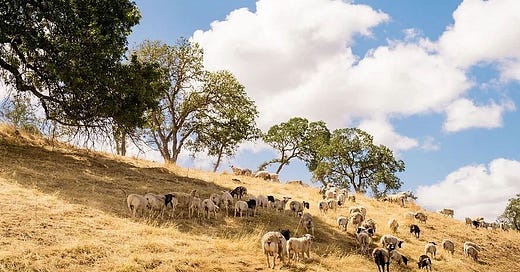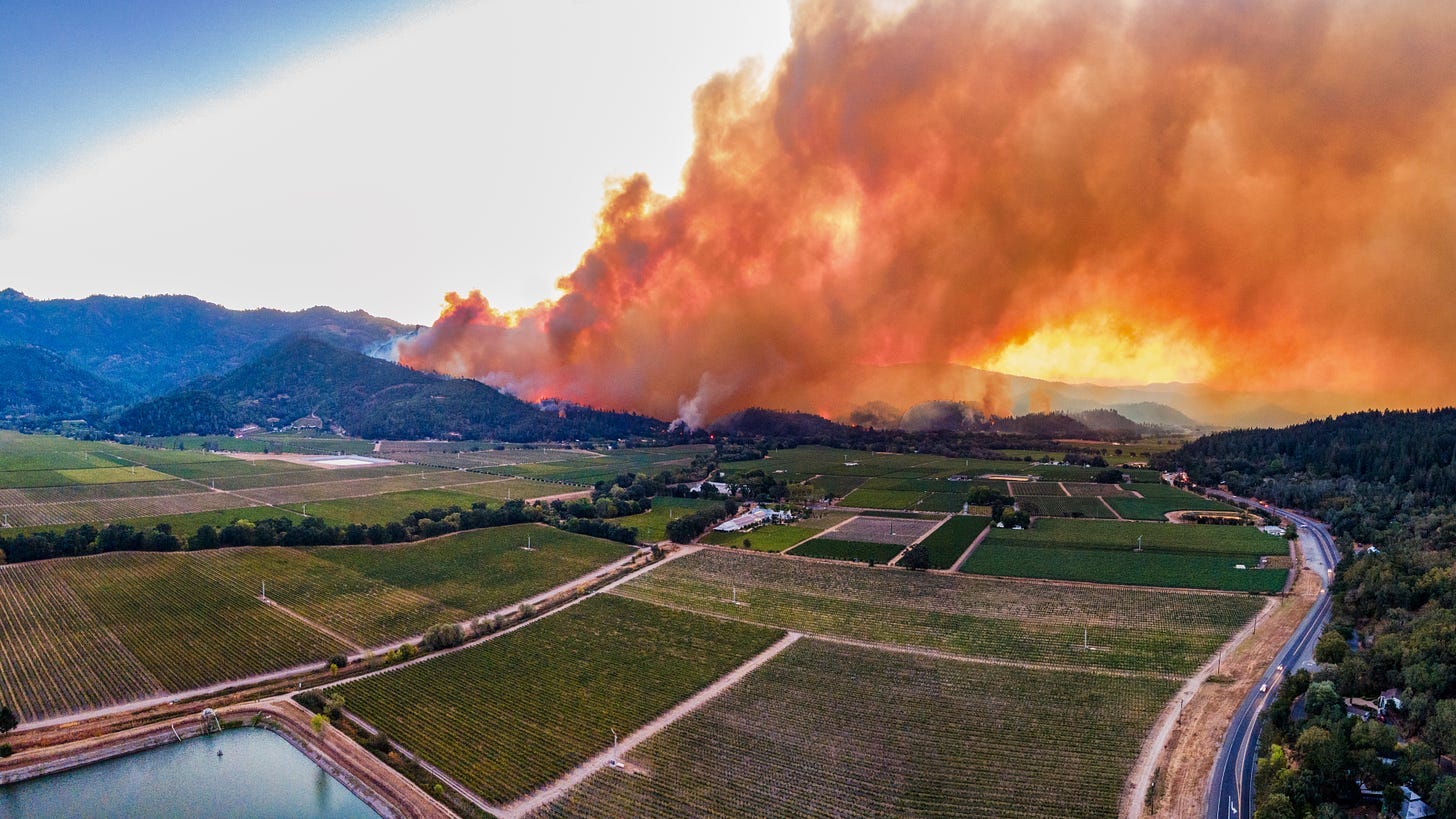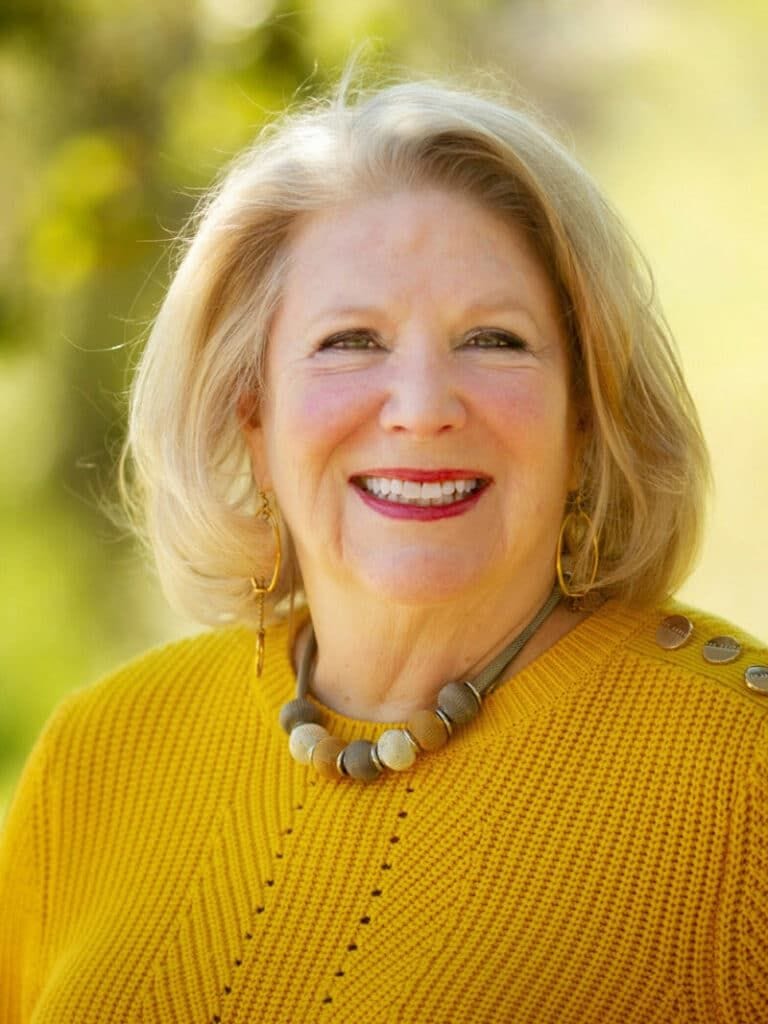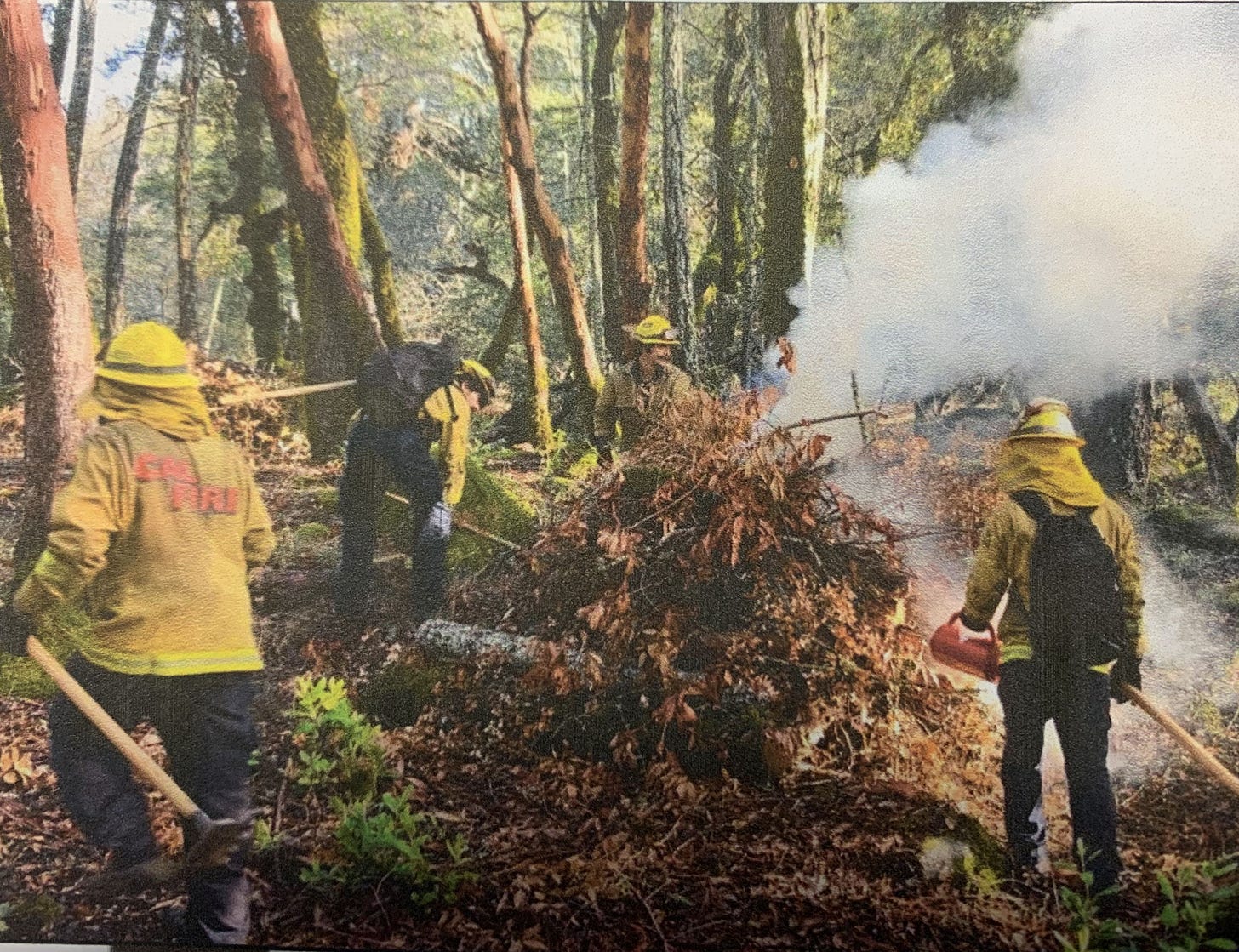Napa Firewise, community groups collaborate for strengthened wildfire protection
By Dave Stoneberg
NAPA VALLEY, Calif. — A new collaborative effort is aimed at helping Napa County protect itself from the devastating wildfires it has seen in years past. Last May, less than three years after the destructive September 2020 Glass Fire, Cori Carlson, founder of Napa Pasture Protein, a family ranch located on Capell Valley Road in Napa, brought 500 sheep and goats to 97 acres bordering Highway 29 and Bothe-Napa Valley State Park.
According to a video posted by the Spring Mountain Fire Safe Council, Carlson estimated that it would take between 30 to 45 days to rid the properties of grasses, weeds and brush to create a fire-resistant property. In a recent interview, Carlson said the herd took 29 days to clear the land, working through about three acres a day. Funds from State Sen. Bill Dodd and private landowners paid for the work.
The cause of the Glass Fire remains undetermined, but its point of origin is suspected to be a machine shed in Deer Park. During its 23-day reign it burned 67,484 acres and destroyed 1,500 structures throughout the Napa Valley, including many on Spring Mountain. Pam Bergman and Vanessa Von Hessert are the volunteer leaders for the Spring Mountain Fire Safe Council, which covers 11,151 acres, including 462 structures. Its population is 339, according to the Fire Safe Council.
In the Napa Valley, 31 Fire Safe Councils are set up, and a few are seeking volunteer leaders. The Fire Safe Councils range from American Canyon in southern Napa County to the northernmost city, Calistoga, which is one of the larger councils, encompassing 34,732 acres, 4,026 structures and a population of 6,170. Piper Cole is the leader for the Calistoga Fire Safe Council.
The Napa Communities Firewise Foundation (Napa Firewise) is made up of the Fire Safe Councils. Its chair is Christopher Thompson, Cole is vice chair, Linda Cantey is secretary and Paul Heiselmann is treasurer. Its nine directors include Cyril Chappellet, JC Greenberg, Elaine Honig, Phil Husby, Rick Jones, Jerry Newell, Tom Scripps, Chris Warner and Mike Wink.
Federal and local grants
Creating a fire-resilient landscape is just one example — there are several — of the collaboration in Napa County. One is the third annual Napa Fire Resources Fair, which will be held Saturday, March 16, from 10 a.m. to 2 p.m. at the Napa Valley Expo, 575 Third St. in Napa. Presenting the fair are the Napa Valley Grapegrowers, Napa Valley Vintners, CalFire, Napa County Fire and Napa Firewise.
This community-wide event is free to the public and will feature exhibitors providing resources for wildfire prevention and mitigation. Highlights include talks by David Shew, Napa County fire administrator and fire captain, on defensible space and fuel-load reduction, as well as a range of kid-friendly activities such as the Nimbus Arts Nim-bus and fire-hose target practice. OHM Coffee and Tacos El Muchacho Alegre will sell refreshments.
Another collaborative effort resulted in the county’s receiving a $37.5 million federal Building Resilient Infrastructure and Communities grant, with an additional $9.3 million provided by the county. The Federal Emergency Management Agency grant will play a pivotal role in bolstering Napa County's efforts to implement the previously adopted Napa County Community Wildfire Protection Plan, an all-encompassing wildfire mitigation program, reinforcing long-term wildfire and climate resilience for its residents and communities.
According to a county news release published in August, “The CWPP, adopted by the Napa County Board of Supervisors in 2021, sets forth an ambitious agenda to mitigate risks to human life, property and critical infrastructure. Key actions encompass the strategic removal or modification of vegetative fuels, the creation of vital fuel breaks and the implementation of fire-resistant vegetation. Additionally, the initiative prioritizes fortifying evacuation routes, securing drinking-water reservoirs, and protecting essential facilities while simultaneously enhancing forest health and resilience. These actions collectively reinforce Napa County's enduring wildfire and climate resilience, benefiting countless residents and communities.”
Last year, the Napa Valley Vintners provided a $2.1 million grant for wildfire resiliency in the county. Funds will re-establish or create up to 100 miles of strategic fire roads and fire breaks, establish up to 300 acres of native habitat to reduce wildfire risk and provide ecological benefits, and provide resources and education for 400 landowners and residents on forest health and wildfire resilience.
The NVV is the largest private donor supporting Napa County’s CWPP. The funds were raised through the Collective Napa Valley fall 2022 campaign and will go to Napa Firewise and the Napa County Resource Conservation District. According to a press release, the two agencies will collaborate with local and state government agencies, including the Napa County Fire Department and CalFire and local nonprofits that include the Napa County Land Trust and Napa County Regional Park and Open Space District.
Napa Firewise
On a rainy Wednesday morning in early February, Thompson was talking about Napa Firewise, which began in roughly 2004, although he began serving on the board in 2017. A few board members had resigned because they lost their homes to one of several fires that swept through Napa County that year: the Atlas Peak, Tubbs, Partrick and Nuns fires. In 2017, Napa Firewise ended up with three board members, eight Fire Safe Councils and had received $100,000 from the county for fuel-mitigation work.
Today, there are 13 board members and 31 Fire Safe Councils, and Napa Firewise is working with $12 million a year from various sources for fuel mitigation. Half of that money is from the county, an additional $1 million is a grant from Dodd, which Thompson said they are using for capacity building.
Some of those funds come from two CalFire grants. One is a forest-health grant, Thompson said, for large landscape projects. The grant requires that 1,000 acres be treated, and Napa Firewise is working with Pacific Union College on clearing their forest and adjacent forests owned by others.
“We’ve been working with both entities, trying to integrate them into the overall work that we’re doing,” Thompson said. “Our biggest fear is that a fire starts down in Pope Valley, comes up that hill, reaches the ridge line and then launches into the town of Angwin.”
The forest work is fuel mitigation: limbing trees up to 10 feet so there’s no ground-ladder fuel, removing dead trees and then paying attention to the health of the oaks, particularly in proximity to nearby conifers. The conifers will be cut down to keep the oaks healthy.
“In our forest when this area was first settled, there were between 80 and 100 trees per acre,” Thompson said. “In some places now in the county there’s upward of a thousand trees per acre.”
Thompson is a firefighter with Station 21 in Deer Park, and he knows about fires and forests. For example, in the area of St. Helena’s Bell Canyon Reservoir, conifers grow up next to big oak trees and into their canopies. When a ground fire happens and there’s ladder fuel, the fire transitions from the ground and up into the conifer’s canopy. When the fire reaches the canopy, it lights off because of the oil in the conifer. The fire then goes into the oak’s canopy.
“Oak trees are really robust, especially the trunks, and a ground fire that touches the trunk won’t cause damage,” Thompson said. “But when a fire enters the canopy of an oak, then it’s usually the end of the oak. So when you have a competition between fir trees and oaks, we’re picking out the fir trees and letting the oaks thrive.”
Part of FEMA’s BRIC grant includes assisting homeowners with defensible space and ignition-resistant construction, for example, having fireproof vents on their home. Homeowners will pay for the work to be done, and they will be reimbursed for part of the cost.
Napa Firewise has been working with the county’s new fire administrator, David Shew, to prioritize what projects will be paid for with grant funds. Shew, who had a 32-year career with CalFire, was hired last year. Fifteen of those years were spent with CalFire’s local unit. Their priorities include building and maintaining fuel breaks on ridgelines, increasing the width of fuel mitigation (cutting down dead trees) up to 100 feet on both sides of the roads, restoring existing fire roads and cutting new ones, and performing education and outreach through the Fire Safe Councils. Napa Firewise does its work with the seasoned professionals of CalFire and Napa County Fire Department and its nine volunteer stations.
“For the first time, a real concerted effort is being made by all these agencies, also the fire departments and how they look at fire-suppression issues and then how we look at fire prevention and working together on solving some of these issues,” Thompson said.
“When the large campaign wildfires happened in 2015 and again in 2017, the mentality was that although these fires were bad, it doesn’t happen here a lot,” Thompson said. “We don’t have to make significant changes in our behavior.”
That mentality changed in 2020. These large fires are not unusual; they are the new normal and we need to be prepared for that.
“When I say the new normal, that doesn’t mean that we’re going to have campaign fires every fire season, but it does mean that when we do get one, we gotta be ready,” Thompson said. “It’s not a question of if we’re gonna get it, it’s a question of when.”
Because Northern California or Napa Valley hasn’t faced a huge fire in the last two or three years, it is easy to become complacent. To Thompson, the value of Napa Firewise and its Fire Safe Councils is getting them prepared for the eventuality of a large fire, to pass that knowledge along to its communities (i.e., education and outreach); helping them to pay for and implement their local Community Wildfire Protection Plans; getting their neighborhoods prepared, knowing what to do in case of a red-flag warning; understanding what happens during a PSPS (Public Safety Power Shutoff) and what to do; creating defensible space and using ignition-resistant construction.
“All these elements lead to a safer community,” Thompson said.
Napa County WildFire History
Napa County wildfires since 2020 Glass Fire (Source)
Pope Fire, 61 acres, Oct. 23, 2020
Fremont Fire, 116 acres, Sept. 22, 2021
Newell Fire, 132 acres, Oct. 11, 2021
Old Fire, 570 acres, May 31, 2022
Snell Fire, 103 acres, June 16, 2023
Alta Fire, 14 acres, Sept. 12, 2023
Largest Napa County fires since 2015 (Source)
Jerusalem Fire, 25,118 acres, Aug. 9, 2015
Tubbs, LNU complex, 36,807 acres, Oct. 8, 2017
Atlas, LNU complex, 51,624 acres, Oct. 9, 2017
Nuns, LNU complex, 44,573 acres, Oct. 9, 2017
County Fire, 90,000 acres, June 3, 2018
LNU Lightning Complex, 363,220 acres, Aug. 17, 2020
Glass Fire, 67,484 acres, Sept. 27, 2020
If today's story captured your interest, explore these related articles:
Year-end report: Collaborative efforts increase wildfire resiliency
Wildfire mitigation compliance provides insurance benefits, fire protection
Bracing for the blaze: The wine industry prepares to battle smoke taint
Dave Stoneberg is an editor and journalist who has worked for newspapers in both Lake and Napa counties.













Large fires pose a threat to any local climate action programs. It's hard to replace the carbon emissions from hundreds of thousands of burned trees in any reasonable timeframe..
The impact of wildfire smoke on human health can be huge. Following local fires, pediatricians in the North Bay area noticed a big increase in upper respiratory illnesses in local children, including chronic conditions like asthma. In my own case, since the fires I have a new tendency towards upper respiratory infections (we have no house fan or filter--old home). So I would hope to see some planning and awareness on the pubic health side.